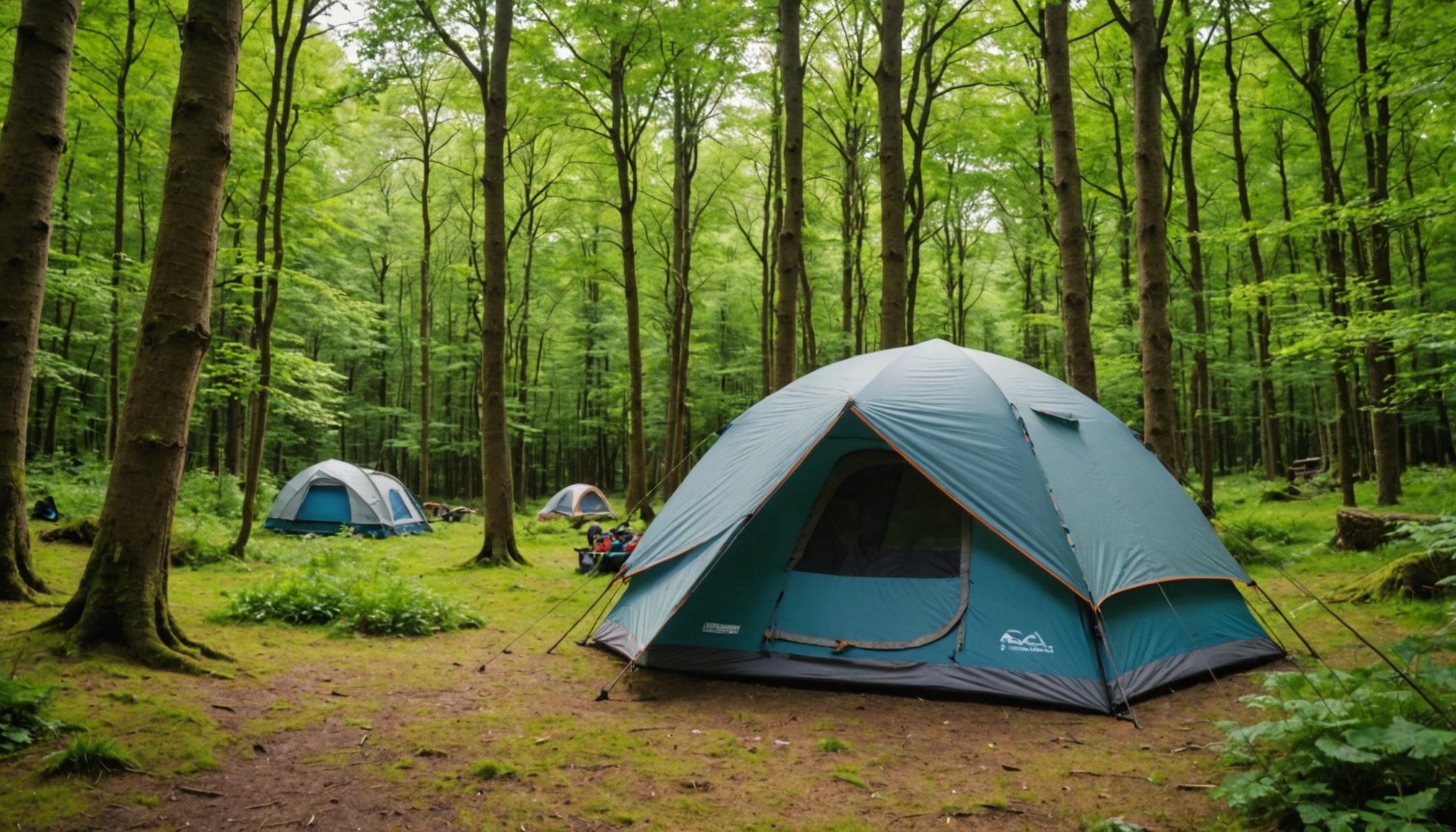Understanding Sustainable Camping Practices
The concept of sustainable camping involves making intentional choices to minimize your impact on the environment. It is crucial as it preserves natural spaces for future generations while ensuring safety for wildlife. Sustainable camping strives to balance human activity and ecological integrity.
What is Eco-Friendly Camping?
Eco-friendly camping includes practices that protect and preserve the environment. Examples are choosing reusable gear, such as camping essentials, and minimizing waste by using biodegradable products. Selecting campsites that adhere to ‘Leave No Trace’ principles ensures that natural landscapes remain untouched.
Additional reading : Finding the Perfect UK Campsite for Your Photography Retreat: A Comprehensive Guide
Impact on Wildlife and Habitats
Camping, while fun, can disrupt local ecosystems. Human presence can threaten wildlife through noise pollution, littering, and habitat destruction. By adhering to sustainable camping practices, campers prevent animal disturbances and protect delicate plant life. This not only conserves wildlife but also fosters biodiversity. Committing to eco-friendly camping is a responsibility that every nature enthusiast should embrace. Sustainable camping ensures outdoor adventures are enjoyable and impactful for both people and the planet.
UK Protected Wildlife Areas
The United Kingdom is home to a variety of protected wildlife areas, each playing a crucial role in preserving biodiversity. These zones are meticulously designated to safeguard the unique flora and fauna native to the region. Among the prominent protected areas include nature reserves such as the New Forest and the Lake District. Both regions harbour diverse ecosystems and are vital for conservation efforts.
Also to see : Top Tips for Keeping Your Tent Dry on Your UK Camping Adventure
Significance for Biodiversity
Protected areas across the UK serve as sanctuaries for countless wildlife species, thus sustaining ecological balance. They act as havens, ensuring the survival of endangered species by providing safe habitats. The ecological processes in these areas also contribute to clean air and water, which benefit both wildlife and human populations.
Local Rules and Regulations
Each region has unique rules and regulations tailored to its specific conservation needs. For instance, the New Forest imposes restrictions on construction and habitat disturbances to protect its indigenous vegetation and animal life. Similarly, the Lake District enforces policies to limit pollution and commercial development. Visitors are encouraged to respect these guidelines to help maintain the fragile ecosystems found within these precious sanctuaries.
Essential Permits and Regulations
Understanding camping permits and local regulations is crucial when planning an outdoor adventure, especially if it involves wildlife-protected areas. Securing the appropriate permits not only allows access but ensures that your camping trip adheres to conservation efforts.
Overview of Necessary Permits
Typically, permits are required to maintain the balance between human activity and natural habitats. Acquiring permits can involve submitting an application through local government websites or visiting dedicated conservation offices. This process may seem tedious, but it safeguards the preservation of natural resources and wildlife.
Specific Camping Regulations
While on site, specific regulations must be observed to uphold legal camping practices. Rules might include setting up camp only in designated areas, adhering to campfire guidelines, and maintaining a safe distance from wildlife. These regulations aim to minimise environmental impact and reduce the risk of accidents.
Consequences of Violating Camping Rules
Failure to comply with camping regulations can lead to significant penalties. Depending on the severity of the violation, campers might face hefty fines, eviction from the campsite, or even legal action. Ignorance of these rules is no excuse, thus emphasising the importance of preparing well ahead of any camping trip by familiarising oneself with local laws.
Equipment for Responsible Camping
Choosing the right camping gear can make a significant difference in reducing your environmental impact. When selecting eco-friendly equipment, consider materials that are biodegradable and designed for sustainability. For example, bamboo utensils and reusable containers are excellent options that help minimize waste.
Prioritizing sustainable supplies not only preserves the natural beauty of camping sites but also enhances your outdoor experience. Look for gear made from recycled or renewable resources, such as tents crafted from recycled polyester or sleeping bags filled with sustainably sourced down. These choices contribute to a cleaner environment while offering high-quality performance.
For those aiming to travel light, lightweight and minimal-impact equipment is essential. Opt for multi-functional items, like collapsible cookware or solar-powered lanterns, which save space and reduce your pack weight. This makes trekking easier and ensures less physical strain without compromising comfort.
When planning snacks and meals, consider biodegradable packaging and eco-friendly alternatives for food storage. Compostable bags and bulk food storage reduce both waste and the number of items carried. Through thoughtful choices in camping gear, you can enjoy a more responsible and sustainable camping trip, preserving the beauty of nature for future generations.
Waste Management and Leave No Trace Principles
Adopting effective waste management strategies is essential when camping. By understanding and following key principles, you ensure that you leave nature as pristine as you found it. The Leave No Trace philosophy is central to maintaining our natural landscapes. It involves planning ahead, travelling on durable surfaces, disposing of waste properly, leaving what you find, minimising campfire impact, respecting wildlife, and being considerate of other visitors.
This approach isn’t just for avid nature enthusiasts – it resonates deeply with anyone yearning to protect the environment. Recycling, for instance, is more than just separating materials; it’s about consciously reducing consumption at its source.
- Pack It In, Pack It Out: Consider bringing reusable items instead of single-use products.
- Food Scraps: Always pack out all food scraps, as they can disturb local wildlife and ecosystems.
- Human Waste: If facilities aren’t available, use a trowel to bury waste at least 200 feet from water sources, ensuring a minimal environmental footprint.
Embracing these principles demonstrates environmental responsibility and encourages others to follow your lead. By integrating these simple, yet impactful habits into your camping routine, you contribute significantly to the conservation of precious natural spaces.
Wildlife Protection and Interaction
Observing wildlife can be a captivating experience, offering glimpses into the authentic beauty of nature. Wildlife protection is paramount during such encounters to ensure animal safety and prevent disturbances in their natural habitat. Adopting responsible behaviour is crucial when interacting with wildlife.
When admiring wildlife, maintaining a safe distance is imperative. Approaching too closely may cause animals stress or provoke unpredictable behaviour. A safe distance allows you to enjoy the sight while ensuring the animals remain undisturbed. This is particularly vital in environments where human presence can disrupt animal routines.
Guidelines for safely observing wildlife include:
- Observing quietly without sudden movements.
- Avoiding feeding, which can alter animals’ natural foraging behaviours.
- Using binoculars or a zoom lens to view from a distance.
In cases where wildlife encounters occur unexpectedly, taking specific actions ensures both human and animal safety. Remain calm and back away slowly, avoiding direct eye contact to prevent perceived threats. If necessary, use deterrents such as loud noises to encourage the wildlife to move away without harm. Understanding these guidelines ensures both memorable and safe wildlife experiences. Remember, respecting wildlife and their surroundings benefits both the animals and the environment.
Resources for Sustainable Camping
Sustainable camping doesn’t just preserve the environment but enhances your outdoor experience. Here’s a compilation of camping resources to help you on your eco-friendly adventure.
Websites and Organizations: Discover useful platforms like Leave No Trace, which offers comprehensive sustainability guides. Their principles guide campers in minimal environmental impact, making your outdoor excursions harmonious with nature.
Apps and Tools: Modern technology provides tools like the Green Camping App that assist in eco-conscious decision-making. These apps offer insights on camping sites known for sustainable practices, helping you make choices aligned with your values without compromising your adventure.
Books and Articles: If you cherish an in-depth understanding, various books delve into eco-friendly camping techniques. Books like “The Green Camping Guide” serve as comprehensive sustainability guides, outlining crucial practices that ensure minimal harm to our beloved outdoor spaces. Additionally, articles from esteemed publications like National Geographic frequently cover emerging camping resources, keeping you abreast of developments in sustainable camping.
Whether using a helpful mobile app or diving deep into literature, these resources for sustainable camping bolster both knowledge and practice, championing an eco-friendly lifestyle outdoors. Explore these options to have a minimal impact while maximising enjoyment and learning during your trips.








